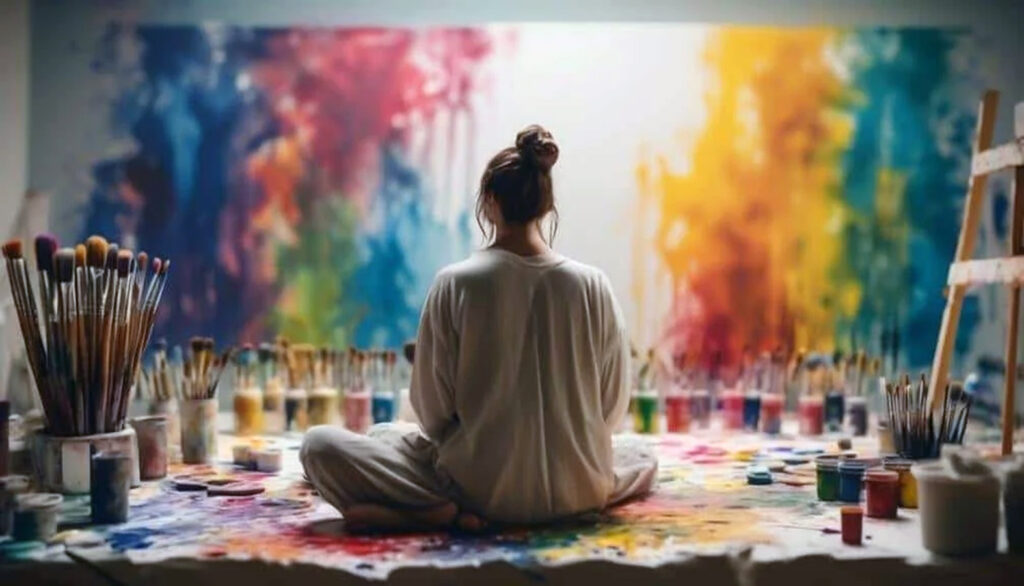
By Anastasia Adaeze
Can Art heal? This is a vital question because therapy is well defined to be an attempted remediation of a health problem following a diagnosis, usually synonymous with treatment, specifically, and psychotherapy. We see art works everywhere. Some even say that, if you pay attention enough you will see art in everything that you do and in everyone. So what is art? Some English dictionaries define art as the conscious production or arrangement of sounds, colours, forms, movements, or other elements in a manner that affects the senses and emotions, specifically the production of a beautiful thing in a graphic, plastic or other medium. With this definition, one could say that art is not bound by time or space.
Notwithstanding, some origins of art date back to the earliest human civilizations, with evidence of artistic expression found in various forms and cultures around the world. This brief overview highlights the vast and rich history of art, spanning thousands of years and numerous cultures:
Prehistoric Art 40,000–4,000 B.C, Ancient Art30,000 B.C.–A.D. 400, Medieval A.D. 500–A.D.1400, Renaissance 1400–1600, Mannerism1527–1580, Baroque 1600–1750, Rococo 1699–1780, Neoclassicism 1750–1850, Neoclassicism 1750–1850, Realism 1848–1900, Art Nouveau 1890–1910, Impressionism 1865–1885, Fauvism 1900–1935, Expressionism 1905–1920, Cubism 1907–1914, Surrealism 1917–1950, OpArt 1950s–1960s, Arte Povera 1960s, Minimalism 1960s–1970s, Conceptual Artmid-1960s–mid-1970s, to the Contemporary Art 1970–present.
Art has evolved, adapted, and innovated over time, reflecting the human experiences, creativity, and imagination. The origins of art therapy can be traced back to the late 18th century when arts were used in the moral treatment of psychiatric patients. However, it wasn’t until the mid-20th century that art therapy became a distinct profession, emerging autonomously in both English-speaking and European countries.
A British artist Adrian Hill coined the term “art therapy” in 1942 when he discovered the therapeutic benefits of drawing and painting while recovering from tuberculosis in a Sanatorium. Mentioned beside his name as pioneers of art therapy are Edward Adamson, E.M. Lyddiatt, Michael Edwards, Diana Raphael-Halliday, Rita Simons and in the United States, Margaret Naumburg and Edith Kramer. As years unfolded, the National professional associations of art therapy was established in many countries, including Britain (1964) and the United States (1969), to continue to raise standards for practice and education.
Art therapy helps people express themselves in ways beyond words, mostly without words. It allows patients to use new mediums to explore their inner emotions, and allows them to use new mediums to explore those inner emotions. This includes patients of all age grades, from young to the old, as activities of arts vary from shape, styles and forms. Art therapy has influenced the roots of the use of arts in moral treatment, by aesthetics, psychiatry, psychoanalysis, rehabilitation, early childhood education, and art education.
In Nigeria, it is safe to say that a good number of people believe in finding hope and light in dark situations especially of chronic health ranks. Despite the cultural diversity, ethnicity and religious differences, the roots of art therapy can be traced to ancient rituals and ceremonies practiced by various ethnic groups, each with its own unique artistic traditions and healing practices. The Igbos have a long tradition of creating intricate sculptures, masks, and textiles for ceremonial purposes, believing that these artistic expressions possess spiritual power and healing properties. Similarly, among the Yoruba people, art is intricately woven into religious ceremonies, such as the Egungun festival, where elaborate masks and costumes are used to commune with ancestral spirits and seek guidance and healing.
In recent therapy practices, traditional Nigerian art techniques have been Integrated and adapted into expressive therapy sessions to promote healing and self-discovery. The use of symbolism, materials, and processes of traditional Nigerian art forms to facilitate therapeutic interventions such as mask-making in therapy sessions allows individuals to explore different aspects of their identity, emotions, and persona, providing a safe space for self-expression and exploration. Textile design techniques, such as tie-dyeing and weaving, can be used to explore themes of resilience, transformation, and cultural identity. Also the tactile nature of pottery provides individuals with a sensory experience that promotes grounding, mindfulness, and emotional regulation. These mentioned techniques keep in cognizance the rich artistic traditions of Nigeria and its people.
Some challenges affect the promotion of art therapy in Nigeria, such as cultural stigmas and limited resources. Stigma around mental health issues can deter individuals from seeking or accessing therapy services, including art therapy. A shortage of trained art therapists in Nigeria limits service availability in urban and rural areas. The lack of awareness about expressive therapy benefits among professionals hinders its widespread adoption, expressive therapy, promoting holistic well-being and cultural connection. Hope lingers for more acceptance of art therapy with organisations such as Ayo Akinyemi Centre for Research & Art Therapy. The Centre empower individuals, create researches and documentations on lost and emerging African Art. It also advocates changes that uplifts, unite, teach, heal and build communities. In 2015, the project Arts in Medicine by Tender Arts Nigeria to transform the healthcare experience for patients, family members, and caregivers evidently shows that efforts are made to seek increase in awareness of art as a form of therapy for patients that is different from the use of injections, drugs and other conventional methods. Arts in Medicine Project; UNICEF and the Norwegian Government; Sickle Cell Foundation Nigeria amongst others with testimonies of how expressive therapy has transformed the lives of countless individuals, offering hope, healing, and empowerment. The expressiveness of art therapy holds a high hand in healing Nigeria and Nigerians of the present and of the future just by embracing its transformative power and leveraging Nigeria’s rich artistic heritage, expressive therapy can empower individuals, strengthen communities, and contribute to a brighter and more resilient future for all.

